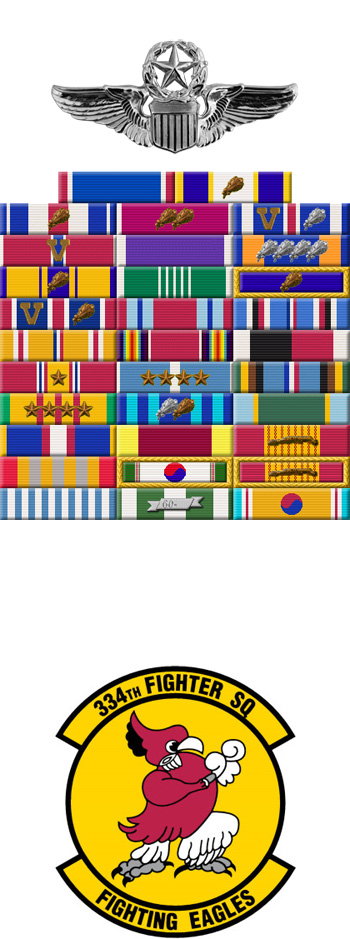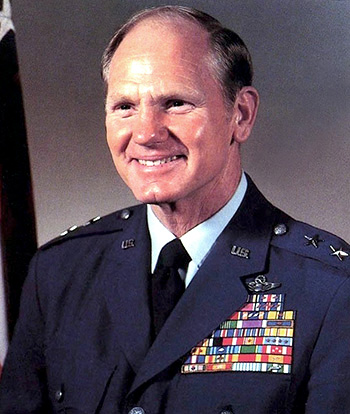
|
Frederick C. Blesse |
 |
|||
| Rank, Service | ||||
Major General O-8, U.S. Air Force |
||||
| Veteran of: | ||||
|
||||
| Tribute: | ||||
Boots Blesse was born on August 22, 1921, in Colon, Panama. He graduated from American High School at Manila in the Philippines in 1939, and he entered the U.S. Military Academy at West Point in 1942. Blesse was commissioned a year early due to World War II, graduating from West Point and being awarded his pilot wings on June 5, 1945. After completing gunnery training and P-47 Thunderbolt training, he was assigned to the 1st Fighter Squadron of the 413th Fighter Group on Okinawa from March to October 1946, and then with the 25th Fighter Squadron of the 51st Fighter Group, also on Okinawa, until March 1948. During this time, Blesse transitioned to the F-80 Shooting Star jet fighter. His next assignment was with the 63rd Fighter Squadron of the 56th Fighter Group at Selfridge AFB, Michigan, where he served from March 1948 to November 1950, followed by a combat tour with the 67th Fighter-Bomber Squadron (FBS) of the 18th Fighter-Bomber Group (FBG) in Korea from November 1950 to February 1951, and then with the 7th FBS of the 49th FBG until returning to the U.S. in June 1951. Maj Blesse then served with the 94th Fighter-Interceptor Squadron (FIS) at George AFB, California, until April 1952, when he returned to Korea for a second tour, this time with the 334th FIS, returning to the U.S. in October 1952. During the Korean War, Blesse flew 223 combat missions in F-51 Mustang, F-80 Shooting Star, and F-86 Sabre fighters, and he was credited with destroying 10 enemy aircraft in aerial combat plus 1 probable and 3 more damaged. From December 1952 to February 1956, he served as a gunnery instructor and squadron commander at Nellis AFB, Nevada, and he was on the Air Training Command Fighter Gunnery Team in 1954 and 1955. During this time, he wrote the book "No Guts, No Glory", which has been used as a basis for fighter combat operations for many of the world's air forces since 1955. He transferred to Randolph AFB, Texas, in February 1956, and served as chief of the Fighter Division of Crew Training until April 1958, when he was assigned to the 32nd Fighter Interceptor Squadron at Soesterberg AB, Holland, serving as commander of the squadron before returning to the United States in August 1961. He was then assigned as a member of the Air Staff with the inspector general at Norton AFB, California, where he served until August 1965. Col Blesse next attended National War College in Washington, D.C., and F-4 Phantom II Combat Crew Training before serving as Director of Operations for the 366th Tactical Fighter Wing at Da Nang AB in the Republic of Vietnam from April 1967 to April 1968. During this time, he flew 145 combat missions over North Vietnam, South Vietnam, and Laos. Gen Blesse next served as Director of Operations for the 474th Tactical Fighter Wing at Nellis AFB, Nevada, from May 1968 until becoming the Wing's commander in June 1969. He was made Commander of the 831st Air Division at George AFB, California, in June 1970, and then served as Assistant Director of Operations for 7th Air Force at Tan Son Nhut AB in the Republic of Vietnam from January to July 1971. Gen Blesse then became Assistant Deputy Chief of Staff for Operations followed by Deputy Chief of Staff for Operations at Headquarters Pacific Air Forces at Hickam AFB, Hawaii, where he served from July 1971 to November 1973. From November 1973 to August 1974, he served as senior Air Force member on the Weapons Systems Evaluation Group in the Office of the Secretary of Defense, followed by service as Deputy Inspector General of the U.S. Air Force, where he served from August 1974 until his retirement from the Air Force on April 1, 1975. Boots Blesse died on October 31, 2012. |
||||
|
||||

